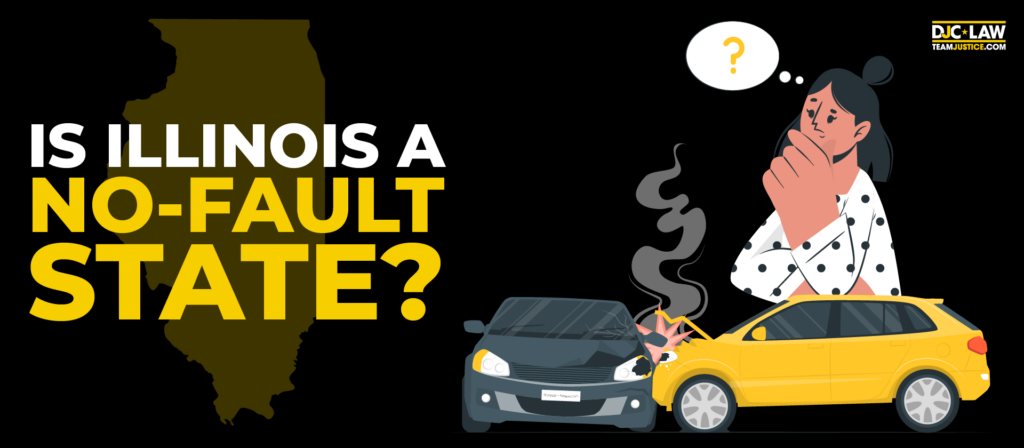
How an auto accident is dealt with depends on whether you live in a no-fault vs. at-fault state. Some U.S. states are no-fault states, meaning you file a claim with your insurance company, and they handle it.
But Illinois is one of 38 states categorized as an at-fault state, meaning drivers are liable for any injuries they cause on the roads. With 817 crashes occurring daily in 2022 (Illinois Department of Transportation), the roads are growing more dangerous, meaning it’s vital to know how The Prairie State’s car insurance system works.
Let’s discuss everything you must know about the insurance system of Illinois.
Key Takeaways
- Is Illinois a no-fault state? It’s an at-fault state, meaning at-fault drivers are responsible for covering the damages of any injured parties.
- Every driver in Illinois must have a minimum amount of liability coverage, including for bodily injury, property damage, and accidents involving uninsured/underinsured motorists.
- Insurance adjusters determine who was at fault, including accounting for comparative negligence laws if both parties were deemed partially responsible.
- Available evidence like police reports and eyewitness accounts are pivotal to deciding which driver was at fault.
- All drivers should protect their rights by documenting the scene, calling the police seeking medical attention, and keeping meticulous records before contacting a personal injury attorney to claim compensation.
Understanding No-Fault vs. Fault Insurance Systems: How Does Illinois Compare?
Is Illinois a no-fault state? The answer is no. As an at-fault state, any injuries sustained on the road are the responsibility of the at-fault driver. The primary difference is how claims for injuries are made.
In at-fault states like Illinois, all drivers who cause injuries are responsible for compensating the injured parties for their losses. In contrast, a no-fault insurance system means injured parties file car accident claims with their own insurers, regardless of who was at fault.
Of course, that doesn’t mean money is paid out of your own pocket in Illinois. Instead, drivers must carry additional cover in at-fault states to cover the costs of an accident if they were responsible.
Illinois car insurance requirements state every legal driver must have:
- Bodily injury liability coverage worth $50,000 per car accident.
- Property damage liability coverage of $20,000.
- Uninsured motorist bodily injury coverage of $50,000 per accident.
How is Fault Determined in Illinois Car Accidents?
Recovering compensation in an at-fault state like Illinois requires proving the four elements of negligence: duty, breach, causation, and damages.
Here’s how they work:
- Duty – Every driver has a duty of care, meaning they must operate their vehicles safely and in compliance with traffic laws.
- Breach – Examples of breaches include failing to maintain your vehicle, driving under the influence, speeding, and other road traffic violations.
- Causation – Did the driver’s breach of duty directly lead to the car accident resulting in injuries or property damages?
- Damages – The final element shows that the victim suffered monetary losses because of another driver. This could be anything from medical bills and property damage to lost wages and auto repair bills.
It’s the job of an experienced Illinois car accident attorney to prove that these four elements are in place to prove negligence and win you the compensation you deserve.
Who Determines the Cause of an Accident?
Insurance company adjusters examine all available evidence to determine who was responsible for the collision. Typically, the representatives of both drivers’ auto insurance companies will collaborate to decide who was at fault.
This can be a simple or a process that drags on. For example, you may be required to answer questions about the car accident to build a narrative of what happened. Likewise, they’ll examine evidence like police and witness reports.
If there are conflicts regarding who was at fault, this is where Illinois personal injury lawyers may find themselves in a courtroom fighting for their clients.
How Insurance Companies Determine Fault in Illinois Car Accidents?
Insurance companies send in adjusters to evaluate the evidence and determine fault. This includes reviewing police reports, interviewing involved parties, and examining vehicle damage. Of course, insurance adjusters are humans, and they only provide their opinions, meaning you can challenge their claims through an Illinois auto accident attorney if you feel they have come to the wrong conclusion.
An insurance company’s decision on who was at fault isn’t legally binding. Most claims are managed through settlements, but others require legal intervention. If the issue of who was at fault can’t be resolved, you can file a lawsuit.
Filing a lawsuit means the courts will evaluate all available evidence, consult Illinois law, and determine fault and appropriate damages.
What is Comparative Negligence in Illinois?
Comparative negligence determines how responsibility for a car accident is divided. Illinois doesn’t operate on a system whereby one driver takes all the responsibility. Instead, there are situations whereby some accidents were caused by the actions or inactions of both sides.
Whenever both parties are deemed partially at fault, the comparative negligence law decides who receives compensation and how much they receive.
For example, if Driver A was speeding and Driver B was drunk and collided, both parties were partially responsible. Comparative negligence laws determine who was most liable and who should receive damages.
According to the Illinois General Assembly, under 735 ILCS 5/2-1116, Illinois operates using modified comparative negligence rules, meaning injured parties only receive monetary compensation if they were deemed less than 50% at fault for the car accident.
Illinois Car Insurance: Understanding the Fault-Based System
Unlike in a no-fault state, the fault-based system in Illinois means that it’s the driver’s responsibility to cover damages if they’re responsible for a car accident. In practice, this means the at-fault driver’s insurance company is responsible for covering any losses sustained by the victim.
However, if you’re an injured party, you can also file a separate personal injury lawsuit to claim additional damages. If successful, you can receive extra compensation for lost wages, pain and suffering, medical bills, and property damage.
In contrast, in a no-fault state, you’d simply file an insurance claim with your own insurer, and – from a civil perspective – it’s irrelevant who the at-fault party was because both drivers will file claims with their own insurer. The idea behind Illinois’ at-fault laws is to lower auto insurance premiums by making drivers responsible for their actions.
What are the Auto Insurance Requirements in Illinois?
Like every state, Illinois requires all drivers to require a minimum level of auto insurance. However, as an at-fault state, all drivers must carry additional insurance coverage to be considered “road legal.”
The minimum amount you must carry follows the $25,000/$50,000/$20,000 model, meaning that your limits are $25,000 per person for bodily injury and $50,000 maximum per incident. Furthermore, your policy must cover up to $20,000 in property damage coverage.
You must also have liability insurance coverage to provide a legal defense if a lawsuit is brought against you. If you’re an Illinois resident, you have bodily injury and property damage liability coverage. There’s also a separate aspect of auto insurance policies that cover accidents caused by uninsured and underinsured Illinois drivers.
How to Prove Liability in an At-Fault State Like Illinois
Proving liability requires car accident victims to show that the driver had a duty of care, that the driver violated that duty of care, that the driver’s actions/inactions caused harm, and that the victim (you) suffered monetary loss.
Proving these four aspects requires using evidence from the accident scene to demonstrate that the other driver was at fault. This is why enlisting a Chicago car accident lawyer is critical.
What Key Evidence Can Strengthen Your Case in an Illinois Car Accident?
Evidence is required to back up your case and avoid a game of he said, she said. Various types of evidence exist to bolster your case, including:
- Admissions of fault, which could be as simple as an apology made by the driver at the scene.
- Statements from each driver.
- Statements from witnesses.
- Official police reports.
- Photographs of the scene.
- Videos of the scene.
- Traffic camera footage.
- Vehicle damage.
- Medical records.
- Testimony from car accident reconstruction experts.
Like any personal injury case, you can never have too much evidence. The key is gathering as much evidence as possible at the scene while everything is fresh.
How Evidence Impacts the Average Personal Injury Settlement in Illinois
Evidence is the only way to prove that the other driver was at fault. Remember, insurance adjusters represent their companies, and it’s their goal to pay out as little as possible. This means they’ll question evidence and try to unearth evidence of their own to prove that their driver wasn’t at fault or they were only partially to blame. With the average car accident settlement in Illinois being over $26,000, the strength of your evidence will determine how much you’re actually awarded.
Common Mistakes to Avoid When Gathering Evidence After a Car Accident
The biggest mistake you can make at an accident scene is failing to gather evidence. If you’re physically able and it’s safe to do so, use your phone to snap photos and videos. Provide as much evidence as possible by taking photos and videos of multiple angles, focusing on vehicle damage, road conditions, and the orientation of vehicles.
Likewise, always call the police and ask for an officer to attend. Official police accident reports carry substantial weight in personal injury lawsuits.
What’s the Role of Police Reports in Determining Fault in Illinois Car Accidents?
Official police reports are vital in determining fault in Illinois car accidents because they’re objective accounts based on what a respected public authority saw. Each report contains statements from everyone involved, damage reports, and citations. This is why insurance companies rely heavily on them to determine liability.
Always call the police after an accident. Although you can file your own report within ten days of an accident online, this doesn’t carry the same gravitas. Plus, if your case does go to court, judges typically side with the police official who wrote the report.
Can you have your police report changed if you believe a mistake was made? In rare cases, yes, but it’s entirely down to the officer’s opinion.
How Do Witness Statements Influence Fault Determination in Illinois?
Witness statements have a tremendous influence on fault determination, especially if gathered at the scene of an accident. Eyewitnesses offer an opinion on what they saw, which insurance adjusters use to help decide which driver was at fault.
If you’re at the scene of an accident, you can also gather witness statements. However, eyewitnesses aren’t required to provide a statement or give you any contact details. If an eyewitness agrees, ensure you gather their contact details and record their statement using your phone (if they permit it).
Note that if eyewitnesses are present, the attending officer will include their statements in their official report.
Steps to Take Immediately After a Car Accident to Protect Your Rights
Personal injury lawsuits are often derailed because of the actions drivers take at the scene. In the immediate aftermath, you may be injured, confused, or in shock. However, your actions in the next few minutes could determine the outcome of your case.
Here’s what to do after a car accident to protect your rights:
- Call – Call the police, and if you’re injured, call 911 for the emergency medical services.
- Fault – Never admit fault to the other driver or the police. This could be as innocent as apologizing, but any indication that you were somehow responsible will impact your chances of getting the settlement you deserve.
- Trust – Never trust the at-fault driver. It’s not uncommon for drivers to urge others not to call the police and to work it out between themselves, but in many cases, this doesn’t just impact your case but might also be a violation of Illinois traffic law.
- Document – Document the scene using your video. This should include all injuries, the vehicles, the road conditions, road signs, and any damage caused to vehicles or other property.
- Talk – Speak to any eyewitnesses who may be present and ask for their contact details. The more eyewitnesses you have who can testify to your account, the stronger your personal injury claim will be.
- Medical Attention – Always get your injuries checked out, even if you feel fine, as some injuries may not appear for a few hours. Keep any records, such as doctor’s notes and medical bills. Plus, it goes without saying that you should follow any prescribed treatment plan.
- Damage Records – Document your damages, such as auto repair bills, medical bills, and any mandatory time off work. This will be vital for assessing your losses.



